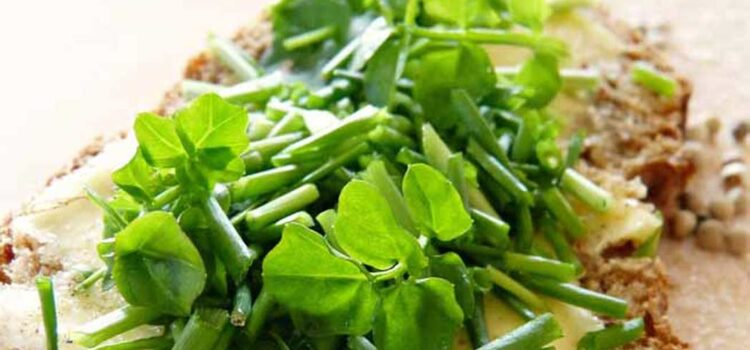Health Benefits of Watercress

Watercress, one of the oldest green leaf vegetables in the world, has a distinguished flavor and hardy constitution. This plucky perennial has amazing cancer-fighting properties and was long used to treat scurvy. Keep in mind that watercress is most potent when consumed fresh and raw.
Watercress provides more vitamin C than oranges, more calcium than whole milk, more vitamin B than blackcurrants and more iron than spinach. In fact, Irish monks used to refer to the plant as “pure food for sages.”
Good for You
Watercress may be a small, humble leaf, but its health benefits are amazing. Watercress is high in calcium, carotenes, folic acid, zinc, iron and vitamins A, B, C and E. It also helps in reducing eczema and wrinkles, maintaining strong bones and protecting against stroke, heart disease, cataracts. In addition, it works as blood purifier, diuretic and expectorant.
Farming & Production
On a trip to Hawaii, GAYOT visited Sumida Farm on Oahu, the largest watercress producer in the islands, to witness firsthand how this leafy green vegetable is produced. The farm, responsible for 70 percent of all the watercress produced in Hawaii, contains natural ground springs and allows them access to an abundance of cool, crystal-clear filtered water from the Pearl Harbor aquifer. While most of the watercress consumed in the continental United States is produced in Florida, Sumida Farm’s 300 tons produced per year go to local markets, hotels, and restaurants, as none of the product is exported.
Patches are harvested by cutting the plant and leaving it to regenerate, while a special pressure chamber is used to quick-chill the product before distribution. As David Sumida says, “It’s amazing how it works, but it really preserves freshness in the vegetable. Not much has changed since 1928 when my grandparents started the farm. We have a few other things growing for personal consumption and a few fishes here and there. It is truly an ideal place with five million gallons pouring out every day.”
Cruciferous Cancer-Fighter
Individuals can lower their risk of lung and colon cancer by eating high amounts of cruciferous vegetables. Studies have suggested that the sulfur-containing compounds (specifically sulforaphane) that give cruciferous vegetables their bitter bite are also what give them their cancer-fighting power. Even better, two cups of fresh watercress contains only 7 calories.
K is for Keeper
In addition to vitamin C, watercress is a good source of vitamin K, which helps maintain healthy bones. Vitamin K improves calcium absorption and reduces urinary excretion of calcium. Eating just one cup of watercress would meet your daily need for vitamin K.
Commonly found in health food stores, watercress has become more readily available thanks to consumer awareness about healthy eating. You can always enjoy watercress in a salad, but treat it like any other green and saute it in pastas or casseroles to lend a mild peppery finish. Just keep in mind that the tender watercress will cook faster than tougher greens such as kale.




